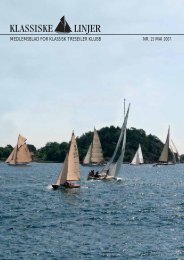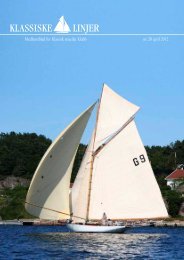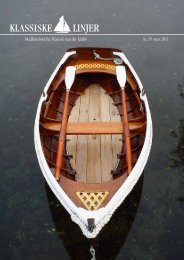Klassiske Linjer nr 10 1999 - Klassisk Treseiler Klubb
Klassiske Linjer nr 10 1999 - Klassisk Treseiler Klubb
Klassiske Linjer nr 10 1999 - Klassisk Treseiler Klubb
You also want an ePaper? Increase the reach of your titles
YUMPU automatically turns print PDFs into web optimized ePapers that Google loves.
26<br />
Seventy years with Johan Anker’s<br />
DRAGONS<br />
SIMON HOLT<br />
By the end of the 1920s, Johan<br />
Anker was firmly established as<br />
the nestor amongst Norwegian<br />
yacht designers. He had also<br />
won a second olympic gold<br />
medal in the 1928 olympics, so<br />
his position as Norway’s premier<br />
yachtsman was equally undisputed.<br />
During 1928 he designed<br />
the winning entry in a<br />
competition organised by the<br />
Royal Gothenburg Yacht Club to<br />
produce a smaller and less<br />
expensive sailing boat for<br />
young people. This design by<br />
Anker was a Bermudan rigged<br />
sloop keelboat with long overhangs<br />
and short coach roof<br />
over a tiny two-berth cabin –<br />
minimal conditions for living<br />
on a boat for two or three days.<br />
Many of us have forgotten what<br />
these looked like but there is still<br />
the rare example dying slowly<br />
in the corner of some boat yard.<br />
Anker named the boat type<br />
DRAGON, and the first was built<br />
in Sweden for the 1929 season.<br />
It quickly became a popular<br />
boat. Norway had some in<br />
1930 and then Germany. The<br />
design shows a boat LOA 8.9m:<br />
LWL 5.7.m: beam 2m with a<br />
draft of 1.2.m and an total<br />
overall weight of 35 cwt.<br />
In 1933 A.H.Ball, a member of<br />
the Clyde Yacht Club, came<br />
back to Britain with the design<br />
after a cruising holiday in<br />
Scandinavia. In 1934 the first<br />
British Dragon was launched<br />
on the Clyde, ANITA (owned by<br />
J.H.Hulme)and the Dragon<br />
Gold Cup was inaugurated by<br />
the Clyde Yacht Club in 1936; it<br />
was to be raced for in Hankø,<br />
Norway, the following year, in<br />
KLASSISKE LINJER NR.<strong>10</strong> MAI <strong>1999</strong><br />
Early Dragon specimen waiting for restoration.<br />
Another DRAGON immaculate after restoration.<br />
honour of Johan Anker. In<br />
1938 there were 25 racing and<br />
at the outbreak of war one<br />
hundred and twenty Dragons<br />
were registered in Britain. Now<br />
there are in the region of 153.<br />
The difference is that in 1938<br />
the price was around £300 and<br />
now is around £30,000.<br />
Dragons were put away for the<br />
war, both in Britain and in<br />
Norway under the occupation.<br />
However, Dragons were<br />
amongst the first boats to<br />
appear again after the war.<br />
Although a luxury at the time,<br />
those who had formally indulged<br />
in big boat racing found in<br />
the Dragon a cost effective<br />
alternative to the old 6, 8 and<br />
12 metre boats. Furthermore,<br />
the heirs to Johan Anker in a<br />
generous gesture had waived<br />
all royalties on British built<br />
boats.<br />
The measure of success can be<br />
judged by the Dragons being<br />
selected in 1948 as an Olympic<br />
Class. The price of this olympic<br />
selection was the end of its days<br />
as a weekend cruising boat.<br />
The Olympic weight rules stripped<br />
out the cruising gear and<br />
the cabin with its pipe cots,






